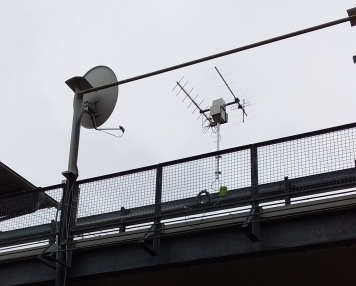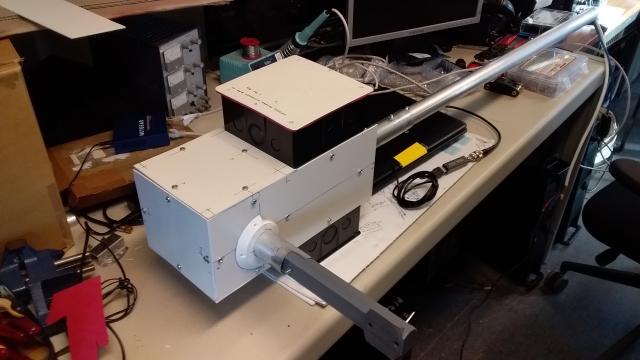Satnogs (Esoc Radio and Cybernetics Club) and
Eumetcast Weather Satellite Image Reception Build Notes and Guidelines. Mark Drapes 20220729
Satnogs build
Satnogs operations
Eumetcast Weather Satellite SW Build
Eumetcast Weather Satellite SW operations


Esoc Radio Club special instructions, no internet, using tethered mobile
Test that the CP2102 TTY Interface and RTL SDR are connected ok (note:the RPI mainboard itself has 3 devices on it): lsusb
Bus 001 Device 005: ID 0bda:2838 Realtek Semiconductor Corp. RTL2838 DVB-T
Bus 001 Device 004: ID 10c4:ea60 Cygnal Integrated Products, Inc. CP2102/CP2109 UART Bridge Controller [CP210x family]
Bus 001 Device 003: ID 0424:ec00 Standard Microsystems Corp. SMSC9512/9514 Fast Ethernet Adapter
Bus 001 Device 002: ID 0424:9514 Standard Microsystems Corp. SMC9514 Hub Bus 001 Device 001: ID 1d6b:0002 Linux Foundation 2.0 root hub
Bus 001 Device 001: ID 1d6b:0002 Linux Foundation 2.0 root hub
Found 1 device(s):
0: Realtek, RTL2838UHIDIR, SN: 00000001
Using device 0: Generic RTL2832U OEM
Found Rafael Micro R820T tuner
Supported gain values (29): 0.0 0.9 1.4 2.7 3.7 7.7 8.7 12.5 14.4 15.7 16.6 19.7 20.7 22.9 25.4 28.0 29.7 32.8 33.8 36.4 37.2 38.6 40.2 42.1 43.4 43.9 44.5 48.0 49.6
[R82XX] PLL not locked!
Sampling at 2048000 S/s.
Info: This tool will continuously read from the device, and report if
samples get lost. If you observe no further output, everything is fine.
Reading samples in async mode...
Allocating 15 zero-copy buffers
lost at least 200 bytes
Testing rotctl and rotctld (hamlib)
Set and Test USB port speed and connection to CP2102 USB-TTY card. Check the CP2102 is plugged in.
sudo rotctl -m 204 -s 19200 -r /dev/ttyUSB0 -vvvvv
sets parameters for controller board type, port speed, port, verbose logging.
Should get the following:
rotctl,
Hamlib 3.3 Report bugs to <hamlib-developer@lists.sourceforge.net>
rot_init
called initrots3_easycomm called rot_register (201) rot_register (202) rot_register (204) rot_open
called serial_open called serial_setup
called Opened rot model 204, 'EasycommIII' rig_strstatus called Backend version: 0.4, Status:
Alpha Rotator command:
See IP-step1 diagram below.
a) RPI: Disable wireless: sudo ifconfig wlan0 down (temporary). Use sudo nano to check /etc/dhcpcd.conf to make sure static ip addresses are #‘ed out. Ie the RPI is on dhcp.
b) On the Win7 laptop disable Wireless adaptor 1. The ethernet adaptor2 should be set to DHCP.
c) smartphone not yet connected

See IP-step2 diagram below.
a) RPI:
b) On the Win7 Laptop when the smartphone is connected via USB a new NDIS network adaptor 3 will appear.
c) Connect smartphone USB to Laptop USB. Enable data usage. Enable tethering (via USB).

See IP-step3 diagram below.
a) RPI: When the laptop windows adaptors have finished reconfiguring themselves (takes 5mins) the RPI will take a matching dhcp address 192.168.137.x
b) On the Win7 laptop the NDIS adaptor ip4 properties should be set to shared. This then forces windows to reconfigure itself. The ethernet adaptor2 which is set to DHCP will assume the ip address 192.168.137.1
c) Smartphone is still connected to Laptop USB with data usage enabled and tethering enabled (via USB).

For Raspberry Pi with full GUI, SD1 or SD2 build, connect laptop to RPI direct via ethernet cable (it can also go through the 4 port Netgear switch).
On laptop open a cmd terminal and type arp -a , this will show the ethernet address of the laptop (which should be on 192.168.137.1) and after a few minutes the ethernet port of the RPI which will pick up a IP address from the laptop eg 192.168.137.53.
When you have the ethernet address of the RPI you can connect to it in VNC (gui).
